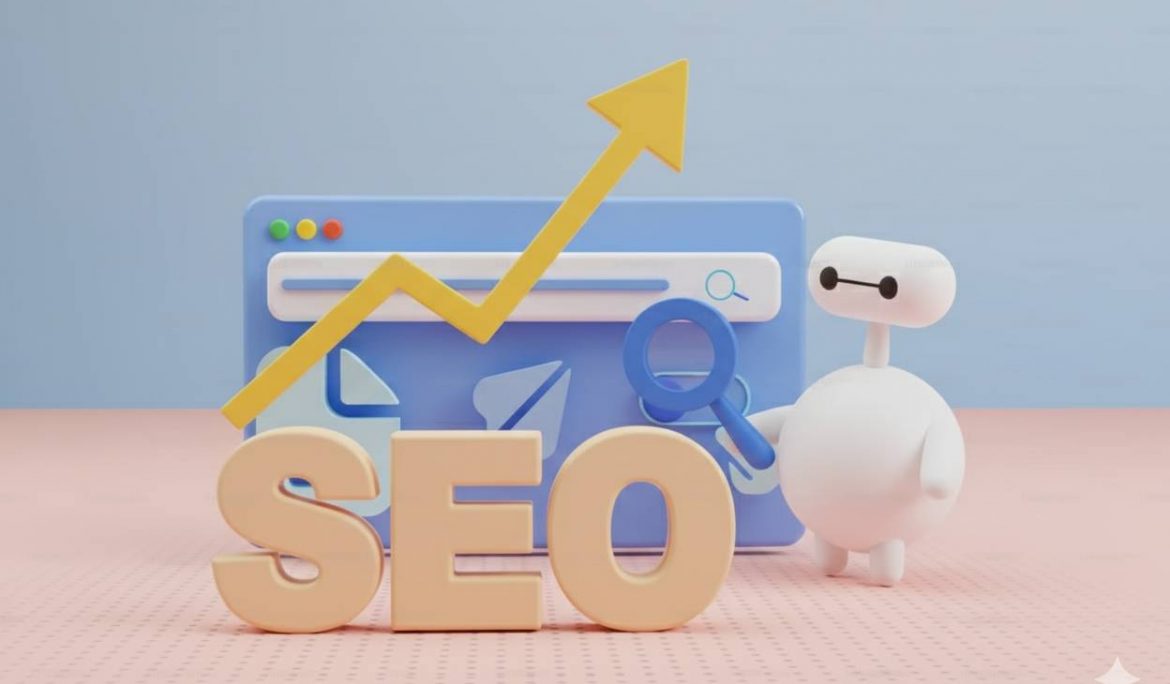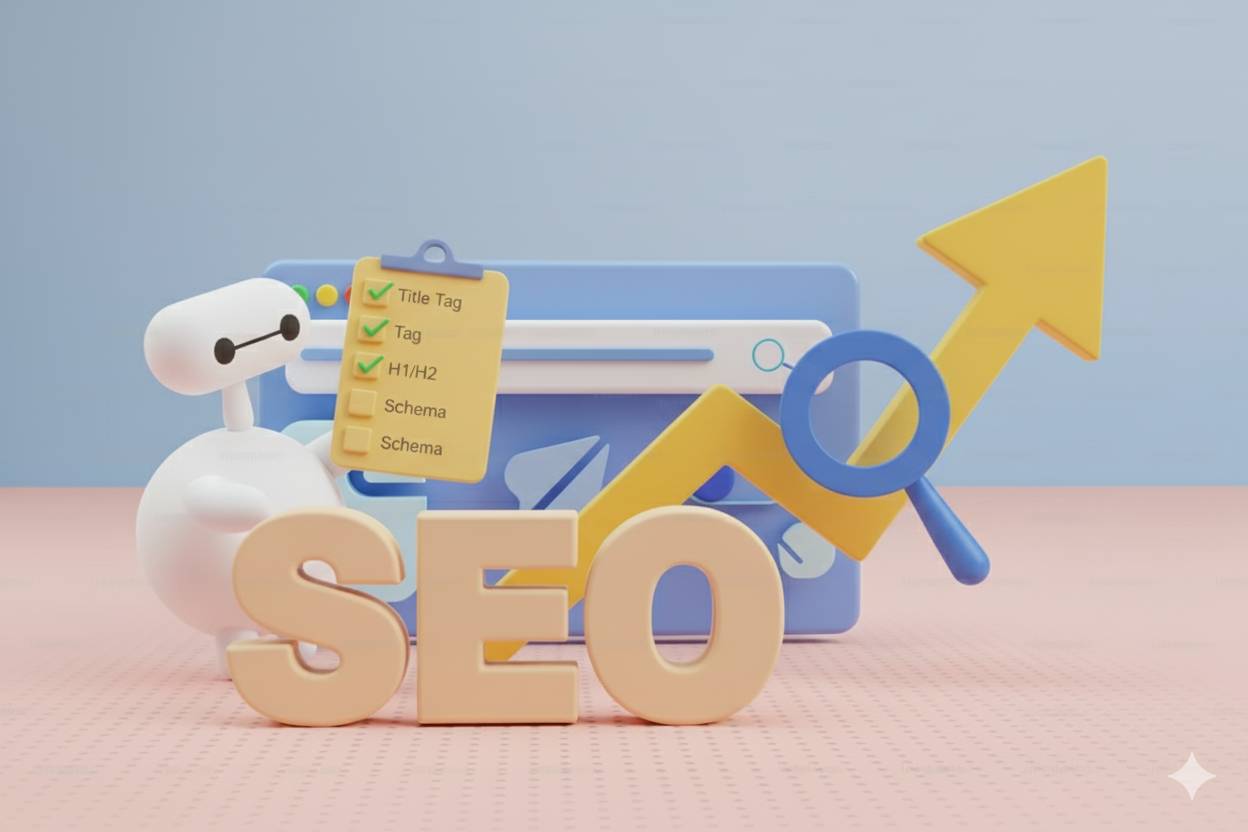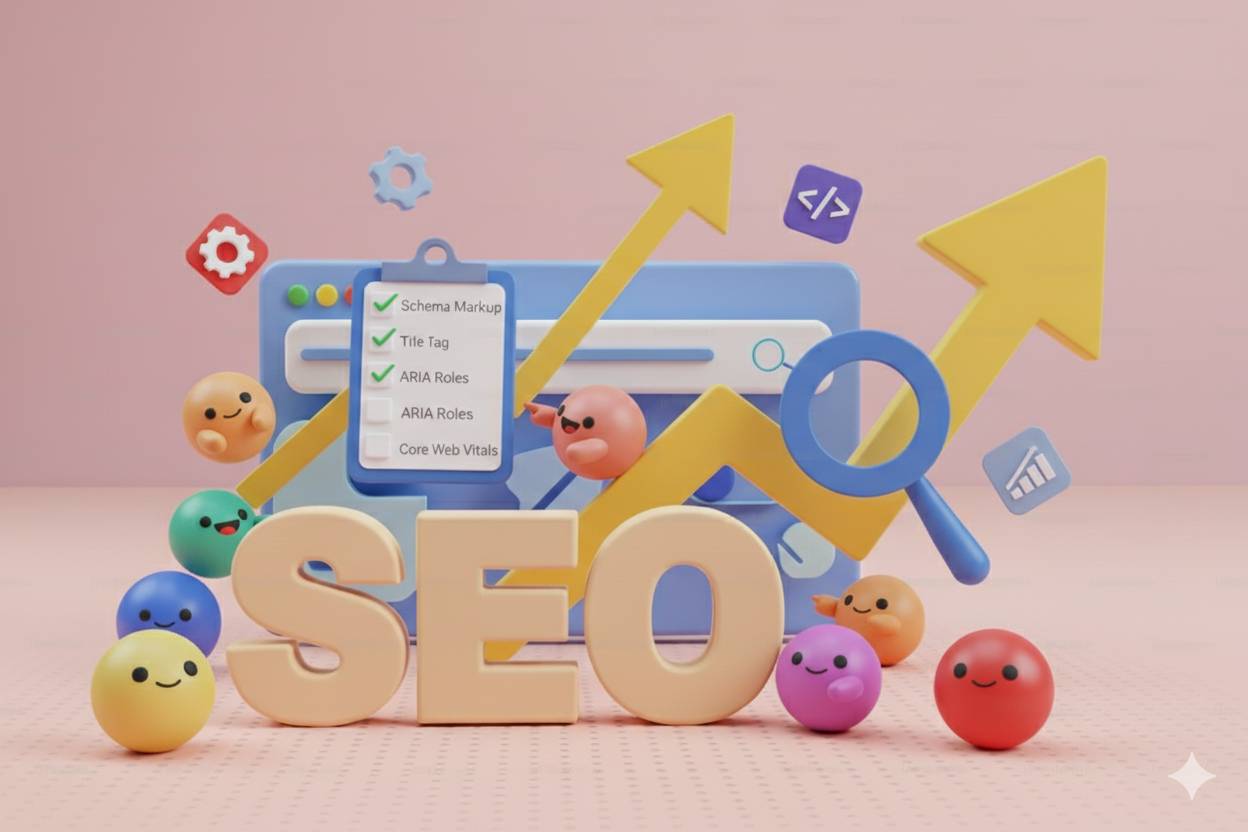
Introduction: On-Page SEO as the Backbone of Rankings
Every SEO campaign starts with two questions:
- What do people search for?
- How does Google decide which page to rank?
The second question, Google’s decision-making, is where on-page SEO matters.
In 2025, off-page signals like backlinks are still important, but on-page SEO steps determine whether your site is even considered in the first place. Without proper on-page optimization, you can have great content and strong links, but Google will struggle to crawl, index, and rank your page.
According to a 2024 SEMrush study, 73% of low-ranking sites had poor on-page SEO checks, despite having strong backlinks. In short: you can’t skip this.
Why a New On-Page SEO Checklist in 2025?
The old checklists covered the basics:
- Optimize your title
- Add H1 and H2s
- Use keywords naturally
But in 2025, search engines look at 200+ signals, and many SEOs miss the advanced SEO on-page optimization checklist items like:
- Advanced schema types beyond FAQ and HowTo
- ARIA roles for accessibility and SEO synergy
- Content pruning for index efficiency
- Log-file insights to understand how Googlebot really crawls your site
This updated on-page SEO checklist combines both the fundamentals and cutting-edge on-page seo hacks to give your pages the best chance of ranking.
What You’ll Get From This Guide
By the end, you’ll know:
- The 25 on-page SEO steps you can implement immediately
- Which on-page SEO checks have the highest impact on CTR, rankings, and engagement
- How to use schema, ARIA roles, and Core Web Vitals to future-proof your site
- How to apply this checklist to different site types: e-commerce, blogs, and local businesses
And yes, you’ll get a free downloadable SEO on-page checklist (Google Sheets + PDF) at the end.
Key Stats That Matter in 2025
- 68% of online experiences still begin with a search engine (BrightEdge, 2025)
- 53% of website traffic comes from organic search
- Core Web Vitals and mobile UX now directly affect rankings
- Schema markup adoption has doubled since 2023, yet 40% of sites still don’t use advanced schema types
If you ignore these on-page SEO steps, you’re leaving traffic, conversions, and revenue on the table.

Fundamentals of On-Page SEO in 2025 (Core 10 Steps)
Even though SEO evolves fast, the fundamentals of on-page optimization are still the foundation. These are the first 10 steps in your on-page SEO checklist 2025 that every site, no matter the industry, must follow.
Step 1: SEO-Friendly URL Structure
A clean URL is easier for both Google and users.
Bad Example:
www.example.com/category.php?id=1234&ref=567
Optimized Example:
www.example.com/seo/on-page-seo-checklist-2025/
👉 Checklist:
- Keep URLs short (3–5 words if possible)
- Use hyphens, not underscores
- Include your primary keyword once
- Avoid numbers/dates unless necessary
Step 2: Title Tag Optimization
The title is the #1 on-page ranking factor and the first thing users see.
Bad Example:
Home | ABC Company
Optimized Example:
On-Page SEO Checklist 2025: 25 Steps to Rank Higher
👉 Checklist:
- Max 60 characters
- Start with the primary keyword
- Add a unique value hook (e.g., “25 Steps You’re Missing”)
- Avoid duplication across pages
Step 3: H1 and Header Tag Hierarchy
Google reads your headers to understand content structure.
Bad Example:
- Page with multiple H1s and no hierarchy
Optimized Example:
- H1: On-Page SEO Checklist 2025
- H2: Core SEO Steps
- H2: Advanced SEO Hacks
- H3: Schema Markup
- H3: Log-File Analysis
👉 Checklist:
- Only one H1 per page
- Use H2s for main sections, H3s for sub-points
- Include keywords naturally in headers
Step 4: Meta Description That Drives Clicks
While not a direct ranking factor, it influences CTR.
Bad Example:
This is a blog about SEO. Learn more about SEO.
Optimized Example:
Master on-page SEO in 2025 with our 25-step checklist. Includes schema, ARIA roles & log-file insights to boost rankings.
👉 Checklist:
- 140–150 characters
- Include primary keyword
- Add a benefit-driven promise
- Avoid generic copy
Step 5: Content Depth & Relevance
Google now measures topical authority. Thin content doesn’t rank.
Bad Example:
A 500-word article on “on-page SEO steps” with only 3 tips.
Optimized Example:
A 3,500-word SEO on-page optimization checklist covering:
- Basics (titles, URLs, headers)
- Advanced hacks (schema, ARIA roles, content pruning)
- Real examples + templates
👉 Checklist:
- Minimum 1,200–1,500 words for competitive terms
- Cover user intent fully
- Add examples, visuals, checklists
Step 6: Internal Linking for Context
Internal links help distribute authority and guide crawlers.
Bad Example:
A blog with zero links to service pages.
Optimized Example:
This guide links to:
- “Best SEO Company in Mumbai” service page
- Related blog posts on technical SEO and content strategy
👉 Checklist:
- 3–5 internal links per 1,000 words
- Use descriptive anchor text
- Link to high-value money pages
Step 7: Image Optimization & Alt Text
Images improve UX but must be SEO-optimized.
Bad Example:
File name: IMG_567.png
No alt text
Optimized Example:
File name: on-page-seo-checklist.png
Alt text: On-Page SEO Checklist 2025 with 25 steps
👉 Checklist:
- Compress images (WebP preferred)
- Add descriptive alt text with keywords
- Use responsive images for mobile
Step 8: Mobile UX Optimization
Google’s mobile-only indexing means your mobile site = your site.
Bad Example:
Desktop site shrunk for mobile, tiny buttons, slow load.
Optimized Example:
- Responsive layout
- Thumb-friendly buttons
- Core Web Vitals optimized (LCP < 2.5s, CLS < 0.1)
👉 Checklist:
- Test with Google Mobile-Friendly Test
- Prioritize above-the-fold load speed
- Use fluid typography and adaptive grids
Step 9: Core Web Vitals & Page Speed
Performance is now a ranking factor.
Bad Example:
Page speed 7.5 seconds, LCP = 4.2s
Optimized Example:
Page speed 1.8 seconds, LCP = 1.9s
👉 Checklist:
- Use PageSpeed Insights + Lighthouse
- Minify CSS/JS, lazy-load images
- Implement CDN + caching
Step 10: Schema Markup Basics
Structured data makes your site stand out in SERPs.
Bad Example:
No schema → plain blue link in Google.
Optimized Example:
Article schema + FAQ schema → Featured snippets + star ratings.
👉 Checklist:
- Use JSON-LD schema
- Start with basics: Article, FAQ, Product
- Validate with Rich Results Test

Advanced Cutting-Edge On-Page SEO Hacks in 2025
Most people stop after optimizing title tags and content. But in 2025, cutting-edge on-page seo hacks are where the real edge lies. These steps take your site from “optimized” to cutting-edge.
Step 11: Advanced Schema Types
Schema goes beyond FAQ or Article markup. Adding advanced schemas can unlock new SERP features.
Example:
- Before: A product page with no schema → Plain listing.
- After: Product schema with price, availability, aggregateRating → Rich result with stars, price, and stock info.
👉 Checklist:
- Use JobPosting schema for hiring pages.
- Add HowTo schema for tutorials.
- Implement the Speakable schema for voice SEO.
- Validate every schema via Google Rich Results Test.
Step 12: ARIA Roles for Accessibility & SEO
ARIA (Accessible Rich Internet Applications) roles don’t just help users with disabilities; they help Google understand structure.
Example:
- Before: A navigation menu coded as <div>s.
- After: Menu with role=”navigation” → Google understands it’s a nav section.
👉 Checklist:
- Add ARIA roles like role=”navigation”, role=”banner”, role=”main”.
- Ensure screen readers and crawlers can interpret elements.
- Test with the WAVE accessibility tool.
Step 13: Content Pruning for SEO Health
Too much old, thin content can hurt rankings.
Example:
- Before: Blog with 500 posts, many under 300 words, no traffic.
- After: Removed/merged 150 thin posts → Organic traffic increased 30%.
👉 Checklist:
- Export pages from GSC + Analytics.
- Identify posts with 0 clicks in 12 months.
- Delete or merge weak pages into stronger content.
Step 14: Log-File Analysis
Logs reveal how Googlebot actually crawls your site.
Example:
- Before: Googlebot wasting crawl budget on old /tag/ pages.
- After: Blocked irrelevant paths in robots.txt, optimized crawl budget.
👉 Checklist:
- Access server logs via hosting or tools like Screaming Frog Log Analyzer.
- Identify pages crawled but not indexed.
- Optimize internal links to guide crawlers.
Step 15: Crawl Depth Optimization
Pages buried deep rarely get crawled often.
Example:
- Before: Important service page at depth 5 (5 clicks from homepage).
- After: Linked from homepage + sitemap → Indexed within 2 days.
👉 Checklist:
- Keep important pages within 3 clicks from the homepage.
- Use breadcrumb schema for better hierarchy.
Step 16: JavaScript SEO Checks
Modern sites often break SEO with JS.
Example:
- Before: React site showing blank pages to Google (content rendered client-side only).
- After: Implemented server-side rendering (SSR) with Next.js → Rankings restored.
👉 Checklist:
- Test with Google’s Mobile-Friendly Test (fetch & render).
- Ensure critical content isn’t blocked by JS.
- Use pre-rendering if SSR is not possible.
Step 17: Semantic Content Clusters
Google rewards topic authority over keyword stuffing.
Example:
- Before: Multiple thin posts: “Best SEO Tools 2023,” “Best SEO Tools 2024.”
- After: One hub: “Best SEO Tools (Updated 2025)” + child pages (reviews, tutorials).
👉 Checklist:
- Create hub-and-spoke content clusters.
- Link spokes back to the hub using descriptive anchors.
- Use LSI keywords naturally.
Step 18: Multilingual & Hreflang SEO
Critical for global businesses or even local ones with Hindi/Marathi content in Mumbai.
Example:
- Before: English-only site → Low engagement in Indian markets.
- After: Added Hindi + Marathi versions with hreflang → +40% local traffic.
👉 Checklist:
- Use hreflang for multilingual sites.
- Translate, don’t just auto-translate.
- Ensure canonical + hreflang consistency.
Step 19: Content Freshness Updates
Google boosts updated pages in competitive niches.
Example:
- Before: “On-Page SEO Checklist 2023” with no updates.
- After: Updated to 2025 edition, refreshed stats, examples → Jumped back to top 3.
👉 Checklist:
- Add “last updated” date.
- Update old stats, screenshots, and links.
- Republish evergreen posts yearly.
Step 20: User Engagement Signals
Google measures satisfaction indirectly via dwell time & CTR.
Example:
- Before: Blog with 10% bounce rate improvement after adding interactive FAQ schema.
- After: Added jump-to links, images, checklists, FAQs → Avg. time on page increased 40%.
👉 Checklist:
- Add FAQ schema for jump links in SERPs.
- Use internal TOCs with jump links.
- Add interactive elements (polls, calculators, quizzes).
21. Semantic Topic Clusters
- What it is: Instead of publishing random blog posts, organize your content into clusters around a core “pillar” topic (e.g., “SEO” → pillar page, then supporting blogs like “on-page SEO checklist,” “off-page SEO techniques,” “technical SEO guide”).
- Why it matters: Google now ranks topic authority, not just individual pages. A cluster strategy signals expertise, helping multiple pages rank together.
- How to do it:
- Identify a pillar keyword (e.g., “SEO services in Mumbai”).
- Create a pillar page (comprehensive overview).
- Write supporting articles answering subtopics.
- Interlink them in a hub-and-spoke structure.
- Tools: Semrush Topic Research, Ahrefs Content Gap, SurferSEO.
22. Multilingual SEO with Hreflang
- What it is: Optimizing your website for multiple languages and regions using hreflang attributes in code.
- Why it matters: In markets like Mumbai, many users search in Hindi, Marathi, or Hinglish. Google uses hreflang to serve the right language/country version.
- How to do it:
- Add <link rel=”alternate” hreflang=”hi-IN” href=”https://example.com/hi/”>.
- Target local keywords (e.g., “dental clinic Mumbai” in English vs “मुंबई डेंटल क्लिनिक” in Hindi).
- Avoid duplicate content penalties by signaling correct language versions.
- Tools: Google Search Console (International Targeting), Hreflang Tags Generator.
23. User Engagement Boosters
- What it is: Adding interactive elements that increase dwell time, reduce bounce rates, and improve engagement signals.
- Why it matters: Google measures user behavior metrics (time on page, scroll depth) to gauge content quality.
- How to do it:
- Add jump links at the top for long articles.
- Use FAQ schema + collapsible sections.
- Embed videos, polls, or quizzes to keep users engaged.
- Add click-to-tweet quotes or data highlights.
- Tools: Hotjar (engagement heatmaps), Typeform (quizzes), and YouTube embeds.
24. Content Experience (CX)
- What it is: Making your page scannable, readable, and enjoyable beyond just words.
- Why it matters: If users can’t quickly scan your page, they leave. Google then lowers rankings.
- Best practices:
- Keep paragraphs 2–3 lines max.
- Use bullet lists for clarity.
- Add relevant visuals every 300–400 words.
- Apply contrast and whitespace for readability.
- Include bold highlights for key insights.
- Pro Tip: Run a readability test (aim for a Grade 7–9 level).
- Tools: Hemingway App, Grammarly, and Figma for visual mockups.
25. Content Testing & CTR Optimization
- What it is: Running A/B tests on meta titles, descriptions, and CTAs to see what drives more clicks and conversions.
- Why it matters: Even if you rank high, a low CTR (Click-Through Rate) means wasted impressions. Small tweaks can double organic clicks.
- How to do it:
- Export low-CTR pages from Google Search Console.
- Rewrite meta titles/descriptions with power words + numbers.
- Add emojis or brackets (if relevant) for SERP standout.
- Run A/B split testing (e.g., GSC experiments, Google Optimize).
- Tools: Google Search Console, A/B Testing plugins, RankMath for meta previews.

The Complete On-Page SEO Checklist (2025 Edition)
For a structured and results-driven approach, use this detailed seo on-page checklist to ensure every optimization step is covered and aligned with Google’s best practices. Here’s the step-by-step sequence you can follow. Print this out or use the Google Sheets template (I’ll outline it below).
🔹 On-Page SEO Checklist (25 Steps)
🏗️ Foundation & Technical Setup
- URL Structure → Keep URLs short, keyword-rich, lowercase, and hyphenated.
- Title Tags → Primary keyword + click-enticing phrase (60 characters max).
- Meta Descriptions → Compelling, 150 characters, include primary keyword.
- Header Tags (H1-H6) → One H1 per page, descriptive H2/H3 sub-sections.
- Canonical Tags → Avoid duplicate content issues.
- Mobile UX & Core Web Vitals → Optimize for speed, interactivity, and visual stability.
- SSL/HTTPS → Must-have for security & trust.
📖 Content Optimization
- Primary Keyword Placement → Title, H1, intro, and conclusion.
- Semantic Keywords (LSI) → Sprinkle related terms naturally.
- Content Depth → Aim for 1,500+ words for competitive topics, add FAQs.
- Internal Linking → 2–3 links to related posts/pages, keyword-rich anchors.
- External Linking → Cite credible sources (gov, edu, authority domains).
- Media Optimization → Compress images, add alt text with descriptive keywords.
- Content Freshness → Update stats, examples, and screenshots annually.
⚙️ Advanced Cutting-Edge On-Page SEO Hacks
- Schema Markup → Use advanced types (FAQ, HowTo, Speakable, Product, JobPosting).
- ARIA Roles → Add role=”navigation”, role=”main”, etc. for accessibility & SEO.
- Content Pruning → Delete/merge thin pages with 0 traffic in 12 months.
- Log-File Analysis → Check what Googlebot crawls vs. indexes.
- Crawl Depth → Keep important pages within 3 clicks from the homepage.
- JavaScript SEO → Use SSR/pre-rendering for JS-heavy sites.
- Semantic Topic Clusters → Build hub pages + supporting articles.
- Multilingual SEO → Add hreflang for Hindi, Marathi, and other markets.
- User Engagement Boosters → Add jump links, FAQ schema, and interactive elements.
- Content Experience → Use scannable layouts (short paras, bullet points, visuals).
- Content Testing & CTR Optimization → A/B test titles, meta, CTAs for better clicks.
📊 Downloadable Template Outline
Here’s how your On-Page SEO Checklist Google Sheet should look:
| Step | SEO Check | Why It Matters | Tools to Use | Status (Done/Pending) | Notes |
| 1 | Optimize URL Structure | Helps indexing & readability | Screaming Frog | Pending | Shorten long URLs |
| 2 | Title Tag Optimization | Ranking + CTR boost | GSC, SERP Snippets | Done | Needs A/B testing |
| 3 | Schema Markup | Rich results, higher CTR | Schema.org, RankMath | Pending | Add Product schema |
👉 Columns: Step #, SEO Task, Importance, Tools, Status, Notes
You can expand this into a 25-row checklist that maps 1:1 with the steps above.
❓ FAQs: On-Page SEO in 2025
Q1: How often should I update my on-page SEO?
At least once per quarter, and refresh competitive blogs yearly.
Q2: Does schema still matter in 2025?
Yes. Google continues to reward rich snippets, FAQ, HowTo, and Product schemas still boost CTR.
Q3: Is keyword density still a factor?
Not directly. Focus on natural usage + semantic variety (1–2% max).
Q4: Should I still optimize meta descriptions if Google rewrites them?
Yes. Even if Google rewrites 60%+, well-written metas increase CTR when used.
Q5: How do I measure on-page SEO success?
Key KPIs:
- Rankings for target keywords
- Organic CTR
- Engagement (time on page, bounce rate)
- Conversions
🎯 Conclusion
On-page SEO in 2025 is no longer just about title tags and keywords. It’s about technical precision, semantic authority, accessibility, and user engagement signals.
If you follow this 25-step SEO on-page optimization checklist, you’ll not only improve rankings but also:
- Increase CTR with schema and content testing
- Save crawl budget with pruning + log analysis
- Future-proof your site for AI, voice search, and mobile-first indexing